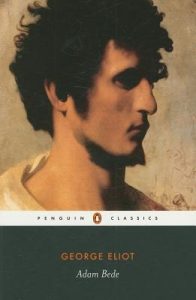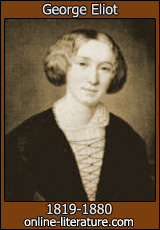 Summary from Goodreads:
Summary from Goodreads:
Carpenter Adam Bede is in love with the beautiful Hetty Sorrel, but unknown to him, he has a rival in the local squire’s son, Arthur Donnithorne. Hetty is soon attracted by Arthur’s seductive charm and they begin to meet in secret. The relationship is to have tragic consequences that reach far beyond the couple themselves, touching not just Adam, but many others, not least, pious Methodist Preacher Dinah Morris.
A tale of seduction, betrayal, love, and deception, the plot of Adam Bede has the quality of an English folk song. Within the setting of Hayslope, a small, rural community, George Eliot brilliantly creates a sense of earthy reality, making the landscape as vital a presence in the novel as that of the characters themselves.
Eliot probes deeply into the psychology of commonplace people caught in the act of uncommon heroics. Alexandre Dumas called this novel ‘the masterpiece of the century.
 Adam Bede by George Eliot
Adam Bede by George Eliot
My rating: 4 of 5 stars
I will tell you up front that this is a difficult read. Not because of the subject matter, but because it requires perseverance and determination to see it through until the end. It is long and very often drags. It is your typical classic. I chose to read this book because I had never read anything by George Eliot, and I figured it might be intriguing.
For the first 200 pages or so, I have to admit that I was ready to “bag” it. But by that time, it seemed ridiculous to quit. And I had begun to care about one of the main female characters, Hetty. In fact, I figured I knew what would happen to her, and I was almost disappointed when there were very few clues that I was right. But I was–no spoilers, so I will not say any more on this topic.
I am grateful that I read a version of this book that had annotated notes–I would have been lost without them. I had no trouble understanding the Biblical references, but I was not aware of the English climate and mindset of 1799 and following.
I would liken the story of this book to book: Tess of the D’Urbervilles. I will say that Thomas Hardy was a much better writer than George Eliot. George Eliot did way too much editorializing. Then again, she wrote this book to point out religious and class distinction flaws. Her writing did not flow like Hardy’s did. And his characters enraptured me from the beginning.
George Eliot did manage to put in some twists and turns that I did not expect. There were times that I determined to finish a chapter, and I had to move on because I was too curious about what happened next. But the ending rather baffled me because I did not see how that matched up with her premise. But I guess that’s my opinion.
If you would have asked me to rate this book two weeks ago, I may have given it a 2 or 3 star rating. However, as with most classics, it was hard reading, but well worth it. I feel that I accomplished something great, and I learned a lot.
After her mother died of cancer in 1836, Mary moved back to the family home “Griff House” on the Arbury Estate. Isaac was back home living with his father in preparation to take over his position on the estate, and Chrissy was also there. Mary helped her run the household and take care of their father. He bought many books for Mary and hired a tutor for her because she had done so well in school–he wanted her to continue her studies. She also found time to write; the Christian Observer published her first poem in 1840. The next year she moved with her now-retired father to “Bird Grove” in Foleshill, near Coventry and embarked on a period of great change. For many years Mary had been self-conscious about her appearance and been plagued by self-doubt; she was afraid of becoming a spinster and tended to melancholy. And she was questioning her Christian faith and forming her own opinions of Victorian society. Her soul searching resulted in her deciding not to attend church anymore, which strained relations with her brother and father. But, another world of purpose and comfort had opened to her; her social circle widened as she was welcomed into Coventry’s intellectual circle. She became friends with irreverent freethinkers like Cara and Charles Bray and started reading non-religious literary works such as those of Thomas Carlyle, Ralph Waldo Emerson, and Sir Walter Scott. She also met publisher John Chapman who printed her first translation, Life of Jesus, in 1846. Another translation of hers’, Feuerbach’s Essence of Christianity, was published in 1854.
When her father died in 1849 after a lengthy illness, Mary travelled with the Brays to Italy and Switzerland. In Geneva she met the D’Albert Durades family and revelled in her freedom. Her father had left her a small yearly income, just enough to live on, and she moved to London in hopes of becoming a journalist as Marian Evans. She roomed at 142 Strand, the home of and offices for Chapman, who was now owner of theWestminster Review. Marian assisted as editor, vetted submissions, and wrote reviews for it. Her keen intellect, years of religious study, knowledge of languages and literature, and work in translations proved invaluable to Chapman and the Review. She was given wide-ranging editorial control and flexed her might as a writer in the non-fiction vein, her articles published anonymously. She enjoyed a particularly unorthodox position as a single working woman in a mid-1800’s male-dominated industry; she was independent and free to make her own choices. But life in London was becoming complicated. Marian fell for the charms of the charismatic Chapman who was married, had a mistress, and was now spending much time with her. Marian was also attending lectures and the theatre, and becoming acquainted with many figures in the publishing world including Charles Dickens, Wilkie Collins, and prolific author, philosopher, and critic George Henry Lewes (1817-1878).
When Marian met the bohemian Lewes he was in an open marriage with Agnes Jervis, but by the end of 1852 he was staying with Marian at her new rooms in Hyde Park. Although now a free-thinker herself, Marian chose not to have children, not wanting them to be born to unmarried parents. Although the Lewes’s never memorialised their union legally, they considered it a marriage despite the derision they received from friends and relatives and the effect it had on their professional careers. Marian now called herself Mrs. Marian Evans Lewes. The two travelled to the Continent a number of times and shared several homes including “Priory” in Regent’s Park, London, and “The Heights” at Witley, until Lewes’ death in 1878. Her lover and her best friend, Lewes was an avid supporter to Marian and encouraged her to take up her pen and write fiction. Despite the public scandal that arose from their relationship, Marian’s most prolific and successful period of writing started with the serialisation inBlackwood’s Magazine of her Scenes of Clerical Life (1858). A collection of three stories, it was her first work published under her pseudonym George Eliot. There were a few reasons for her choosing a pen name at this point in her life; public knowledge of her adulterous relationship with Lewes was one. Another was that, although she had been published anonymously in the Westminster Review, many now knew it was she who wrote with the sharp and cunning intellect that cut away conventions and exposed the mediocrity to be found in literature of the day. Neither male nor female authors were immune to her scrutiny. She did not want her reputation to precede her works. Having a male pen name (‘George’ of course being Lewes’ first name) set a tone for her fiction apart from the feminine genre of cookbooks and domestic moral tales.
Adam Bede (1859) was her first full-length novel. It was an immediate success, but attracted fervent public gossip as to who the real author was. When it was discovered that Eliot was Mrs. Marian Evans Lewes, many castigated her but she was also lauded by friends, fellow authors, and feminists. The dedication in Adam Bederead;
“To my dear husband, George Henry Lewes, I give the manuscript of a work which would never have been written but for the happiness which his love has conferred on my life.”
The Lifted Veil (1859) reflects the personal struggles Eliot went through as a woman and author in the spotlight since the success of Adam Bede. She still felt self-doubt at times and had bouts of depression–this sensitive inner-life reflected in many of the portraits painted of her. But always Lewes was there to urge her forward. Eliot’s most autobiographical novel The Mill on the Floss (1860) was followed by Silas Marner: the Weaver of Raveloe (1861). Her epic historical novel for which she did much research,Romola (1862-3), is based on the life of Dominican Monk Savonarola. It was followed by Brother Jacob (1864) and Felix Holt: The Radical (1866), a political story set in the time of the Great Reform Act of 1832. Eliot wrote many poems including her epic “The Spanish Gypsy” (1868) and “How Lisa Loved the King” (1869). Other poems would be included in The Legend of Jubal and Other Poems (1870). Eliot’s masterpieceMiddlemarch (1871-2) was followed by Daniel Deronda (1876). Around this time the Lewes’s went to live at “The Heights” in Witley, Surrey. George had been sick for some time, and died on 30 November 1878. Eliot was profoundly grieved, but found some comfort in editing his Problems of Life and Mind. She was also working on her own last work, a collection of essays titled Impressions of Theophrastus Such (1879). While Eliot isolated herself from family and friends, she did allow banker John Walter Cross to visit her. Over twenty years his senior, Cross asked Eliot to marry him. Initially she was very reluctant, but in an odd turn of events she accepted. They were married in May of 1880 and Eliot reverted back to her name Mary Ann, only dropping the e. While it was a convention she had rejected for so many years, her marriage did contribute to reconciliation with her brother Isaac. Settling at 4 Cheyne Walk in Chelsea, London, the Cross’s marriage would be short-lived.
George Eliot died on 22 December 1880. She now rests with Lewes in Highgate Cemetery in London, England. Her epitaph reads: “Of those immortal dead who live again, In minds made better by their presence.” Here rests the body of GEORGE ELIOT. (MARY ANN CROSS). Although Eliot’s wish to be buried in Westminster Abbey was not granted, in 1980 a memorial was placed in Poet’s Corner in her honour, among other such esteemed literary figures as William Blake, Aphra Behn, and Henry Wadsworth Longfellow.



